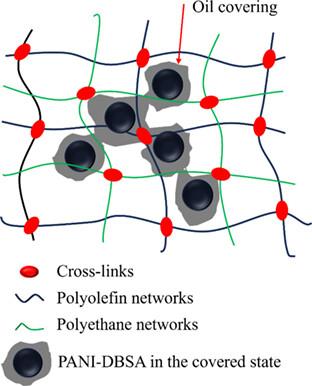求助PDF
{"title":"纳米聚苯胺/聚氨酯互穿网络复合涂层的制备与防腐性能","authors":"Zhenhua Xu, Huan Yu, Tao Fang, Man Zhang, Jiesheng Liu, Xiaoming Tan","doi":"10.1002/pi.6577","DOIUrl":null,"url":null,"abstract":"<p>Polyaniline−dodecylbenzene sulfonic acid (PANI-DBSA) particles were synthesized through <i>in situ</i> lotion polymerization of aniline and DBSA as raw materials, followed by combining with epoxy resin (E-44) and castor oil (CO) to prepare a PANI mixture (PANI-DBSA/CO) which was used as a nanofiller to create a nano polyaniline/polyurethane (PANI-PU) interpenetrating polymer network (IPN) coating. SEM, XRD and Fourier transform infrared spectroscopy were used to characterize the PANI-DBSA and PANI-PU IPN composite coatings that were produced. The coatings’ physical and mechanical characteristics were investigated, as well as the system's corrosion behaviour in 3.5 wt% NaCl solution, utilizing electrochemical impedance spectroscopy and electrokinetic polarization. Acid, alkali and saltwater immersion investigations were used to further evaluate the coatings’ medium resistance. The results show that when PANI-DBSA is added at 1 wt%, the contact angle reaches 102.6°, the adhesion reaches S1 grade after 720 h immersion, the tensile strength is 16.22 MPa and the elongation reaches 208%. The impedance value of the composite coating grew by 569 times with the addition of 1 wt% PANI, and the resistance duration to 10 wt% H<sub>2</sub>SO<sub>4</sub>, 10 wt% NaOH and 3.5 wt% NaCl reached more than 90 days. The addition of PANI to IPN coatings can increase corrosion resistance and extend their application range. © 2023 Society of Industrial Chemistry.</p>","PeriodicalId":20404,"journal":{"name":"Polymer International","volume":"73 2","pages":"130-140"},"PeriodicalIF":2.9000,"publicationDate":"2023-09-24","publicationTypes":"Journal Article","fieldsOfStudy":null,"isOpenAccess":false,"openAccessPdf":"","citationCount":"0","resultStr":"{\"title\":\"Preparation and anticorrosion performance of nano polyaniline/polyurethane interpenetrating network composite coating\",\"authors\":\"Zhenhua Xu, Huan Yu, Tao Fang, Man Zhang, Jiesheng Liu, Xiaoming Tan\",\"doi\":\"10.1002/pi.6577\",\"DOIUrl\":null,\"url\":null,\"abstract\":\"<p>Polyaniline−dodecylbenzene sulfonic acid (PANI-DBSA) particles were synthesized through <i>in situ</i> lotion polymerization of aniline and DBSA as raw materials, followed by combining with epoxy resin (E-44) and castor oil (CO) to prepare a PANI mixture (PANI-DBSA/CO) which was used as a nanofiller to create a nano polyaniline/polyurethane (PANI-PU) interpenetrating polymer network (IPN) coating. SEM, XRD and Fourier transform infrared spectroscopy were used to characterize the PANI-DBSA and PANI-PU IPN composite coatings that were produced. The coatings’ physical and mechanical characteristics were investigated, as well as the system's corrosion behaviour in 3.5 wt% NaCl solution, utilizing electrochemical impedance spectroscopy and electrokinetic polarization. Acid, alkali and saltwater immersion investigations were used to further evaluate the coatings’ medium resistance. The results show that when PANI-DBSA is added at 1 wt%, the contact angle reaches 102.6°, the adhesion reaches S1 grade after 720 h immersion, the tensile strength is 16.22 MPa and the elongation reaches 208%. The impedance value of the composite coating grew by 569 times with the addition of 1 wt% PANI, and the resistance duration to 10 wt% H<sub>2</sub>SO<sub>4</sub>, 10 wt% NaOH and 3.5 wt% NaCl reached more than 90 days. The addition of PANI to IPN coatings can increase corrosion resistance and extend their application range. © 2023 Society of Industrial Chemistry.</p>\",\"PeriodicalId\":20404,\"journal\":{\"name\":\"Polymer International\",\"volume\":\"73 2\",\"pages\":\"130-140\"},\"PeriodicalIF\":2.9000,\"publicationDate\":\"2023-09-24\",\"publicationTypes\":\"Journal Article\",\"fieldsOfStudy\":null,\"isOpenAccess\":false,\"openAccessPdf\":\"\",\"citationCount\":\"0\",\"resultStr\":null,\"platform\":\"Semanticscholar\",\"paperid\":null,\"PeriodicalName\":\"Polymer International\",\"FirstCategoryId\":\"92\",\"ListUrlMain\":\"https://onlinelibrary.wiley.com/doi/10.1002/pi.6577\",\"RegionNum\":4,\"RegionCategory\":\"化学\",\"ArticlePicture\":[],\"TitleCN\":null,\"AbstractTextCN\":null,\"PMCID\":null,\"EPubDate\":\"\",\"PubModel\":\"\",\"JCR\":\"Q2\",\"JCRName\":\"POLYMER SCIENCE\",\"Score\":null,\"Total\":0}","platform":"Semanticscholar","paperid":null,"PeriodicalName":"Polymer International","FirstCategoryId":"92","ListUrlMain":"https://onlinelibrary.wiley.com/doi/10.1002/pi.6577","RegionNum":4,"RegionCategory":"化学","ArticlePicture":[],"TitleCN":null,"AbstractTextCN":null,"PMCID":null,"EPubDate":"","PubModel":"","JCR":"Q2","JCRName":"POLYMER SCIENCE","Score":null,"Total":0}
引用次数: 0
引用
批量引用




